
 |
Tea Clipper |
 |
| from TeaAntiques.com | ||
| Edition One Hundred and Three |
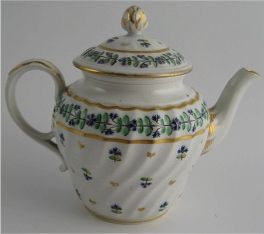
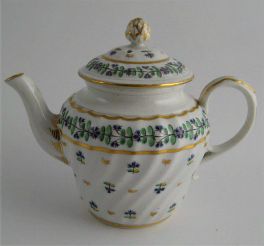 This
is an extremely rare and stunning miniature or 'toy' Flight and Barr teapot
dating from c1795. Such miniatures are rare indeed and were supplied as
children's toy wares and may even have been a Christmas present of Christmas
past? Needless to say such delicate teapots in the hands of children often
failed to survive very long. This teapot was obviously very fortunate.
This
is an extremely rare and stunning miniature or 'toy' Flight and Barr teapot
dating from c1795. Such miniatures are rare indeed and were supplied as
children's toy wares and may even have been a Christmas present of Christmas
past? Needless to say such delicate teapots in the hands of children often
failed to survive very long. This teapot was obviously very fortunate.
The size of the teapot makes it rare, being only 4.5" (115mm) in height to the tip of the lid finial X 6" (152mm) in length from the tip of the spout to back edge of the handle.
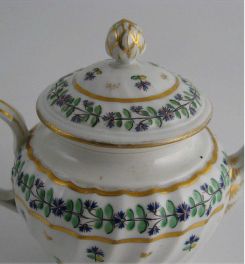
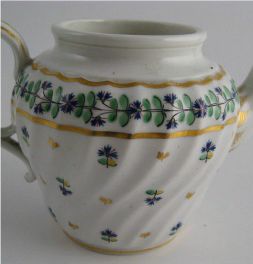
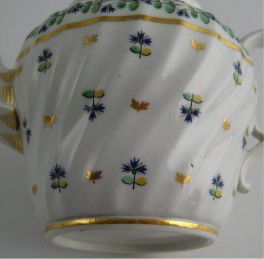
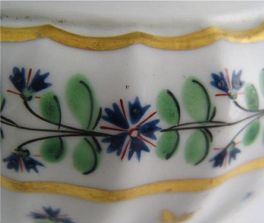
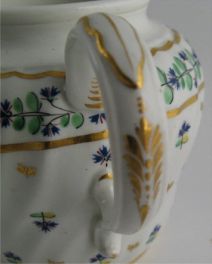 The body of the teapot is of a circular shape, with finely
potted spiral 'shanked' moulding. The entire body is decorated in a charming
cornflower pattern in blue, pink, green and yellow, enriched with wonderful
honey coloured gilding.
The body of the teapot is of a circular shape, with finely
potted spiral 'shanked' moulding. The entire body is decorated in a charming
cornflower pattern in blue, pink, green and yellow, enriched with wonderful
honey coloured gilding.
The cover of the teapot is very pretty, with a moulded pinecone shaped finial which is partially gilded. The cover itself is moulded in the same way as the body of the teapot with spiral 'shanked' lines.
This really is an extremely rare and most magnificent miniature or 'toy ' teapot for the connoisseur collector of eighteenth century porcelain or pieces for the Flight and Barr Worcester factory.
More details of this item and other tea related antiques can be found by visiting my web site at www.TeaAntiques.com.
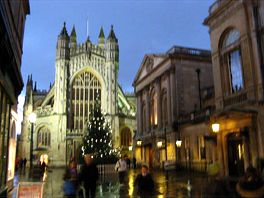 What
better way to start the festive season, than taking a trip to the beautiful
Georgian city of Bath. A day spent in Bath is like taking a trip back in time to
when it was an elegant and genteel place to be, a place where the fashionable
and wealthy would while away the season. Bath is a 'world heritage site' justly
deserved because of its almost unspoilt Georgian elegance and earlier Roman
history.
What
better way to start the festive season, than taking a trip to the beautiful
Georgian city of Bath. A day spent in Bath is like taking a trip back in time to
when it was an elegant and genteel place to be, a place where the fashionable
and wealthy would while away the season. Bath is a 'world heritage site' justly
deserved because of its almost unspoilt Georgian elegance and earlier Roman
history.
A trip to Bath in December is a wonderful thing to do. Here is how a day in Bath can really get you in the festive mood. To arrive nice and early at about 9:30 in the morning gives you time to walk to the centre of the compact City to the Georgian Pump Room. The Pump Room is a magnificent late Eighteenth century building, built as the social heart of Bath, used for assemblies, concerts and the taking of the healing Spa waters that bubble up hot from below ground. The Pump Room is built upon the site of the Roman Baths, which can be seen today and is one of the finest thermal Spa's of the ancient world to have survived.
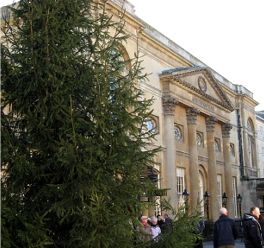 At
10am, the Pump Room restaurant situated in the elegant Pump Room itself opens
for morning brunch, tea, coffee and other lovely food, including Bath buns,
home-made biscuits, crumpets, cakes and scones. Arriving early means that you
can avoid the inevitable queue of people making their way there to relax,
refresh themselves whist listening to the Pump Room trio playing a selection of
light hearted music, which in December includes a few Christmas favourites.
At
10am, the Pump Room restaurant situated in the elegant Pump Room itself opens
for morning brunch, tea, coffee and other lovely food, including Bath buns,
home-made biscuits, crumpets, cakes and scones. Arriving early means that you
can avoid the inevitable queue of people making their way there to relax,
refresh themselves whist listening to the Pump Room trio playing a selection of
light hearted music, which in December includes a few Christmas favourites.
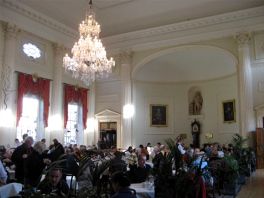 The
place is bathed in daylight, furnished well with round tables bedecked in
starched white table linen and the staff are well presented in uniform ready to
serve. The food is well presented and good value for money, especially being
able to enjoy the charming surroundings and to listen to the live music. The
item that I strongly recommend from the menu is the Pump Room Brunch. This
comprises a tea or coffee of your choice, freshly squeezed orange juice with
ice, eggs Benedict created with ham or spinach on an English muffin, topped with
two soft poached eggs and hollandaise sauce drizzled with mustard dressing. This
is followed by toast, butter and preserves. You are not rushed, so you can
take your time to enjoy it and if you need more tea or coffee you can order more
at no extra cost.
The
place is bathed in daylight, furnished well with round tables bedecked in
starched white table linen and the staff are well presented in uniform ready to
serve. The food is well presented and good value for money, especially being
able to enjoy the charming surroundings and to listen to the live music. The
item that I strongly recommend from the menu is the Pump Room Brunch. This
comprises a tea or coffee of your choice, freshly squeezed orange juice with
ice, eggs Benedict created with ham or spinach on an English muffin, topped with
two soft poached eggs and hollandaise sauce drizzled with mustard dressing. This
is followed by toast, butter and preserves. You are not rushed, so you can
take your time to enjoy it and if you need more tea or coffee you can order more
at no extra cost.
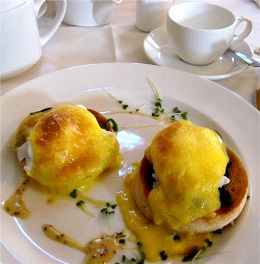
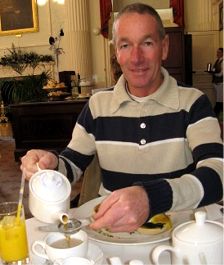
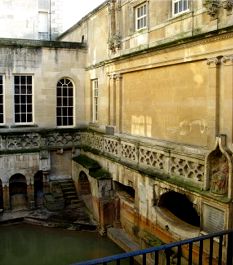
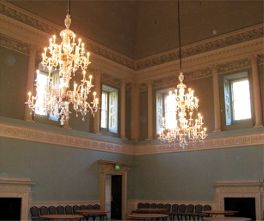 Once
refreshed it is time to hit the City; which due to its compact structure is
perfectly walkable around its centre. I started with a short wander up through
the little lanes that run to one side of the main shopping Street, which is Milsom Street. These little streets and covered arcades are nicely decorated for
Christmas and there are a variety of interesting shops. This leads up the hill
away from the Pump Room to the magnificent Georgian Assembly Rooms. The Assembly
Rooms are free to visit, but the museum of Costume below it attracts a fee. It
is worth a look into the large Assembly Rooms which include the Ball Room,
Octagonal Card Room and a smaller Ball Room. All these rooms are hung with
some stunning Eighteenth Century glass chandeliers. Indeed these are regarded
as some of the very finest in Europe. The main blue Ball Room was used for
evening Balls in the Georgian period, the Card Room for the playing of cards and
gambling.
Once
refreshed it is time to hit the City; which due to its compact structure is
perfectly walkable around its centre. I started with a short wander up through
the little lanes that run to one side of the main shopping Street, which is Milsom Street. These little streets and covered arcades are nicely decorated for
Christmas and there are a variety of interesting shops. This leads up the hill
away from the Pump Room to the magnificent Georgian Assembly Rooms. The Assembly
Rooms are free to visit, but the museum of Costume below it attracts a fee. It
is worth a look into the large Assembly Rooms which include the Ball Room,
Octagonal Card Room and a smaller Ball Room. All these rooms are hung with
some stunning Eighteenth Century glass chandeliers. Indeed these are regarded
as some of the very finest in Europe. The main blue Ball Room was used for
evening Balls in the Georgian period, the Card Room for the playing of cards and
gambling.
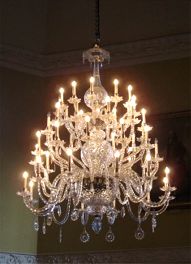
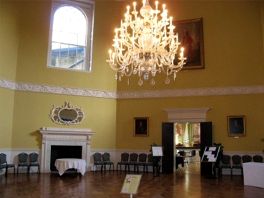
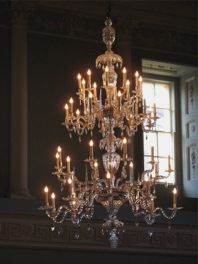
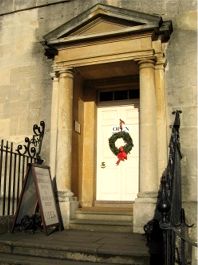 From
the Assembly Rooms, I made my way further up the hill, round the Circus, an
entire three terraced circle of house like a Roman Amphitheatre 'turned outside
in'. Its neo-classical architecture a triumph of John Wood the elder. It is then
but a short stroll to The Royal Crescent, where no 1 is open for Christmas to
illustrate how the Georgians celebrated Christmas and had their houses
decorated. the interior of this fine house is now furnished as it might have
been at the end of the Eighteenth century. There is a gentleman's Study and
Dining Room on the first floor, then above on the second floor, the grand
Drawing Room and Master Bedroom. In the semi basement are the Georgian kitchens
and a small shop for a bit of Christmas shopping.
From
the Assembly Rooms, I made my way further up the hill, round the Circus, an
entire three terraced circle of house like a Roman Amphitheatre 'turned outside
in'. Its neo-classical architecture a triumph of John Wood the elder. It is then
but a short stroll to The Royal Crescent, where no 1 is open for Christmas to
illustrate how the Georgians celebrated Christmas and had their houses
decorated. the interior of this fine house is now furnished as it might have
been at the end of the Eighteenth century. There is a gentleman's Study and
Dining Room on the first floor, then above on the second floor, the grand
Drawing Room and Master Bedroom. In the semi basement are the Georgian kitchens
and a small shop for a bit of Christmas shopping.
The Study of the house is much the Gentleman's domain and has in it a handsome Bureau-bookcase, dining chairs and a Chippendale style card table. This table is set with Georgian glasses, punch bowl, clay pipes for smoking with a twist of tobacco. Playing cards are hung in the sash windows with red ribbons as part of the Christmas decoration.
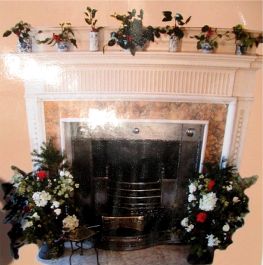 The
Dining Room on the opposite side of the entrance hall to the Gentleman's Study
is beautifully decorated for a Christmas dinner dessert course. The D-ended
dining table is decorated with fresh oranges, pomegranates, pineapples and
greenery in a very formal manner. Porcelain ornaments of putti are scattered
about to add interest to the dinner guests. There is also a fine pair of Derby
sweetmeat dishes; these in the form of a gentleman and lady holding a basket
each with the lid raised to be filled with the sweetmeats maybe tiny comfits of
aniseed used to freshen breath.
The
Dining Room on the opposite side of the entrance hall to the Gentleman's Study
is beautifully decorated for a Christmas dinner dessert course. The D-ended
dining table is decorated with fresh oranges, pomegranates, pineapples and
greenery in a very formal manner. Porcelain ornaments of putti are scattered
about to add interest to the dinner guests. There is also a fine pair of Derby
sweetmeat dishes; these in the form of a gentleman and lady holding a basket
each with the lid raised to be filled with the sweetmeats maybe tiny comfits of
aniseed used to freshen breath.
The elegant Drawing Room above the Dining Room has - to many visitors surprise - a Christmas Tree. Most people regard the introduction of the decorated Christmas tree into England to have been by Prince Albert and Queen Victoria. This is not the case, Christmas trees were introduced by the earlier Hanoverians from their German homeland. George III and Queen Charlotte were recorded as having a Christmas tree at Windsor Castle in 1799, and George IV at his Brighton Pavilion in the early part of the 1800's. The use of the Christmas tree that George III and Queen Caroline had at Windsor is slightly different to how we regard them today. The tree was put up on Christmas Eve, decorated with candles and little presents in baskets. Once the family had taken their presents from the tree it was taken away, unlike now when we keep it up until twelfth night.
Much inspired by the Georgian style decorations at No 1 Royal Crescent, I attempt the same style of decoration in my own Georgian home, including a Christmas tree, card table set with cards, clay pipes and Georgian glasses. The Dining Room table set with fresh fruit, nuts, porcelain, silver and flowers.
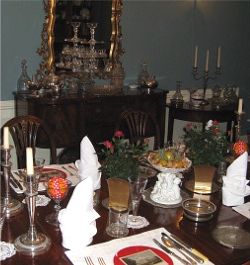
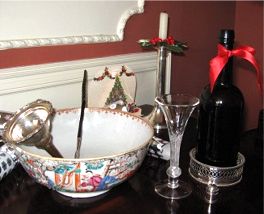
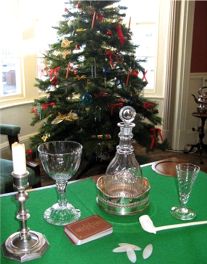
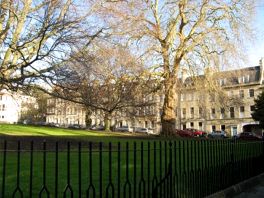
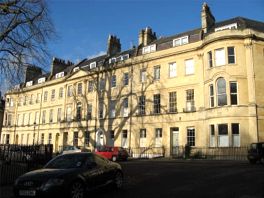 After
an enjoyable step back to Georgian living at No 1 Royal Crescent, I made my way
still further up the hill behind the Crescent to St James Square, This area and
beyond is often out of the tourist track, but believe me, it is worth the walk
beyond the Royal Crescent. St James Square is one of the finest in Bath. It has
two designs of terrace, with the same design facing each other across the
Square. One terrace has bow windows on end house and the other terrace a
triangular pediment in the central house. One interesting house in a corner has
a plaque on its wall proclaiming that the famous Victorian novelist, Charles Dickens, who we often associate with Christmas with his
novel, Christmas Carol, the
story of Ebenezer Scrooge, had stayed. It is said that the little shop tucked in
a nearby alley gave him the inspiration for his novel 'The Old Curiosity Shop'.
The shop, now a house has a 'Curiosity Shop' Cottage name plate below a torch or
'link' extinguisher. This was used by link boys who would light the passage of the
Georgians making their way home from evening entertainments, he could extinguish
or snuff the torch in the torch extinguisher.
After
an enjoyable step back to Georgian living at No 1 Royal Crescent, I made my way
still further up the hill behind the Crescent to St James Square, This area and
beyond is often out of the tourist track, but believe me, it is worth the walk
beyond the Royal Crescent. St James Square is one of the finest in Bath. It has
two designs of terrace, with the same design facing each other across the
Square. One terrace has bow windows on end house and the other terrace a
triangular pediment in the central house. One interesting house in a corner has
a plaque on its wall proclaiming that the famous Victorian novelist, Charles Dickens, who we often associate with Christmas with his
novel, Christmas Carol, the
story of Ebenezer Scrooge, had stayed. It is said that the little shop tucked in
a nearby alley gave him the inspiration for his novel 'The Old Curiosity Shop'.
The shop, now a house has a 'Curiosity Shop' Cottage name plate below a torch or
'link' extinguisher. This was used by link boys who would light the passage of the
Georgians making their way home from evening entertainments, he could extinguish
or snuff the torch in the torch extinguisher.
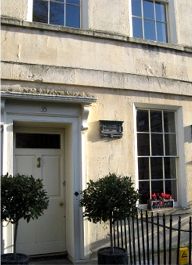
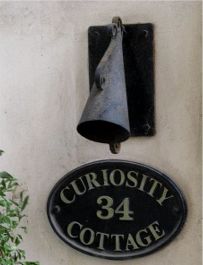
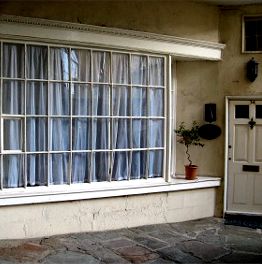
Making my way even further up the steep hill there is the exquisite Camden Terrace, with original metal door canopies, and cast iron window boxes. The houses all have the Georgian style glazing bars and are a uniform set of house creating a fine spectacle.
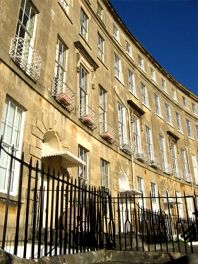
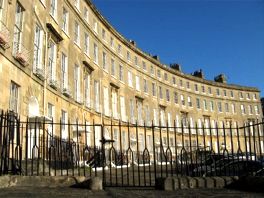
Finally, just a short clamber even further up the hill is Lansdowne Crescent, this one of the most magnificent in Bath. Many of the house in the terrace have their original cast iron overthrows which contain a lantern in the centre. Those whose overthrows had not survived have now been replaced and look incredible as a now complete line of them around the gently curving terrace. Many of the houses are decorated in the traditional way with a Christmas tree in their window and a wreath of greenery hung on the front door.
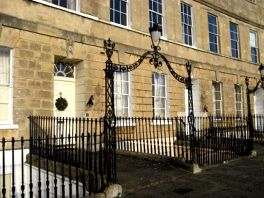
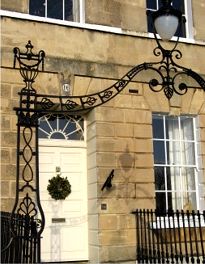
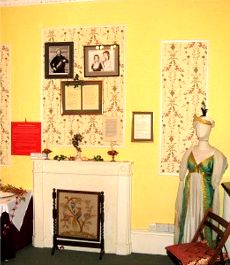
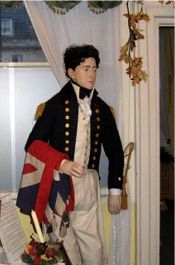 From
Lansdowne Crescent it is a downhill walk back into the centre of the City. I make
my way to 'The Jane Austen Centre', a Georgian House in Gay Street set up as a
museum to the authoress Jane Austen who brought us the fascinating novels that
include 'Pride and Prejudice', 'Sense and Sensibility', Mansfield Park, Emma,
and Persuasion.
From
Lansdowne Crescent it is a downhill walk back into the centre of the City. I make
my way to 'The Jane Austen Centre', a Georgian House in Gay Street set up as a
museum to the authoress Jane Austen who brought us the fascinating novels that
include 'Pride and Prejudice', 'Sense and Sensibility', Mansfield Park, Emma,
and Persuasion.
You are welcomed at the entrance to the Museum by an eighteenth century gentleman of a certain age. I believe that he is probably the most photographed man in Bath.
I have been round the museum several times and have reviewed it in a previous Tea Clipper, but until now had not tried the tearooms. I was in for a pleasant treat, as they serve what I considered to be some of the lightest and freshest scones, with cream and jam that I have had. The service was excellent and polite, the setting elegant, with white table cloths and china. This is a recommended place to have afternoon tea and to rest your feet after a day walking around the many sights in Bath to be enjoyed.
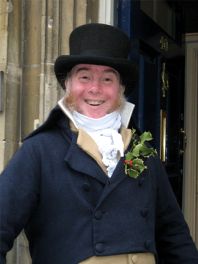
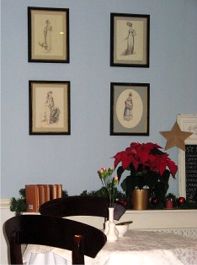
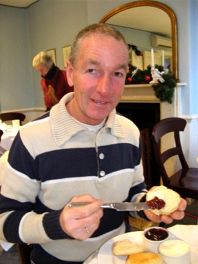
After a fine afternoon tea there was just time to walk round the special 'Christmas Market', with festive wooden shacks holding stalls surrounding the area behind the Pump Room and spectacular Abbey. The market had many various craft, food and gift stalls where you may just stumble across that last elusive present! As the light of the short winters day fades, the lights of the Christmas decorations and the market come alive and the atmosphere builds. Shame that it was then time for me to depart this most magnificent of English Cities.
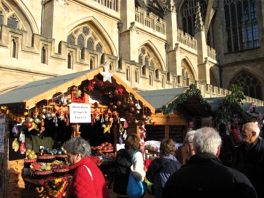
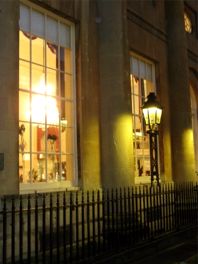
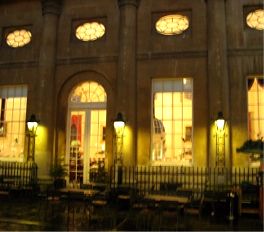
To review past newsletters, just follow this link:
Past newsletters.
To subscribe to this free newsletter -
Click here